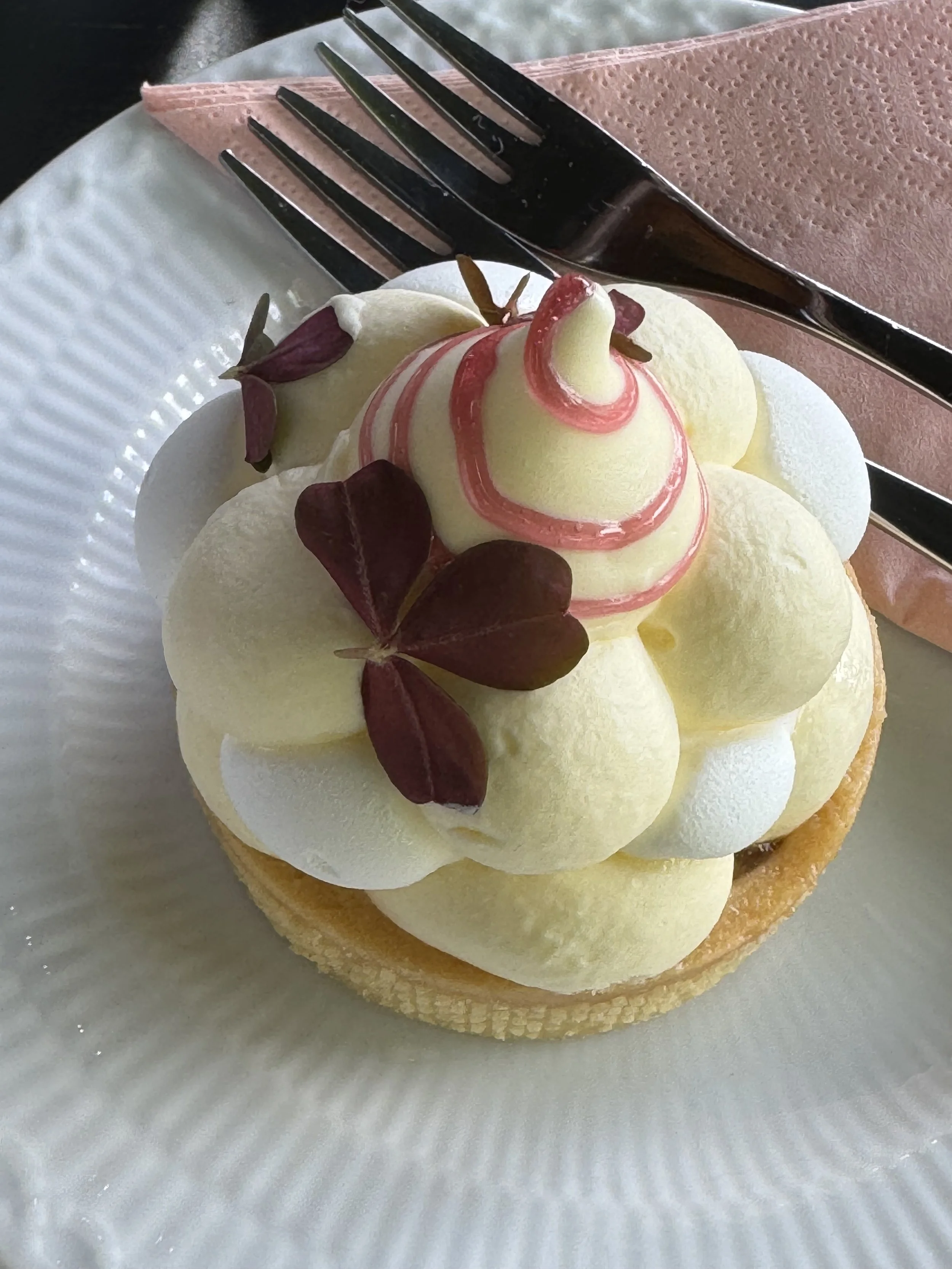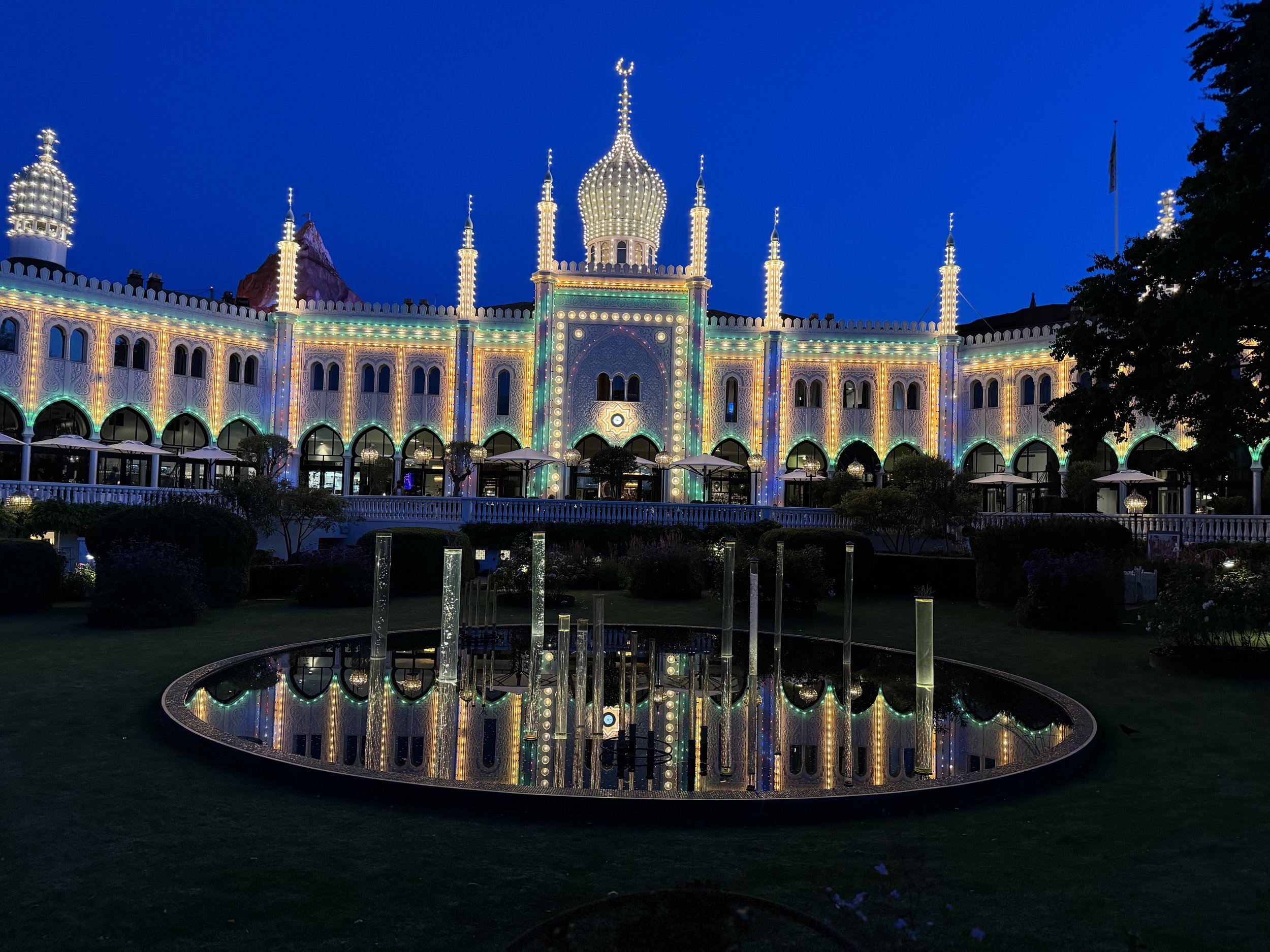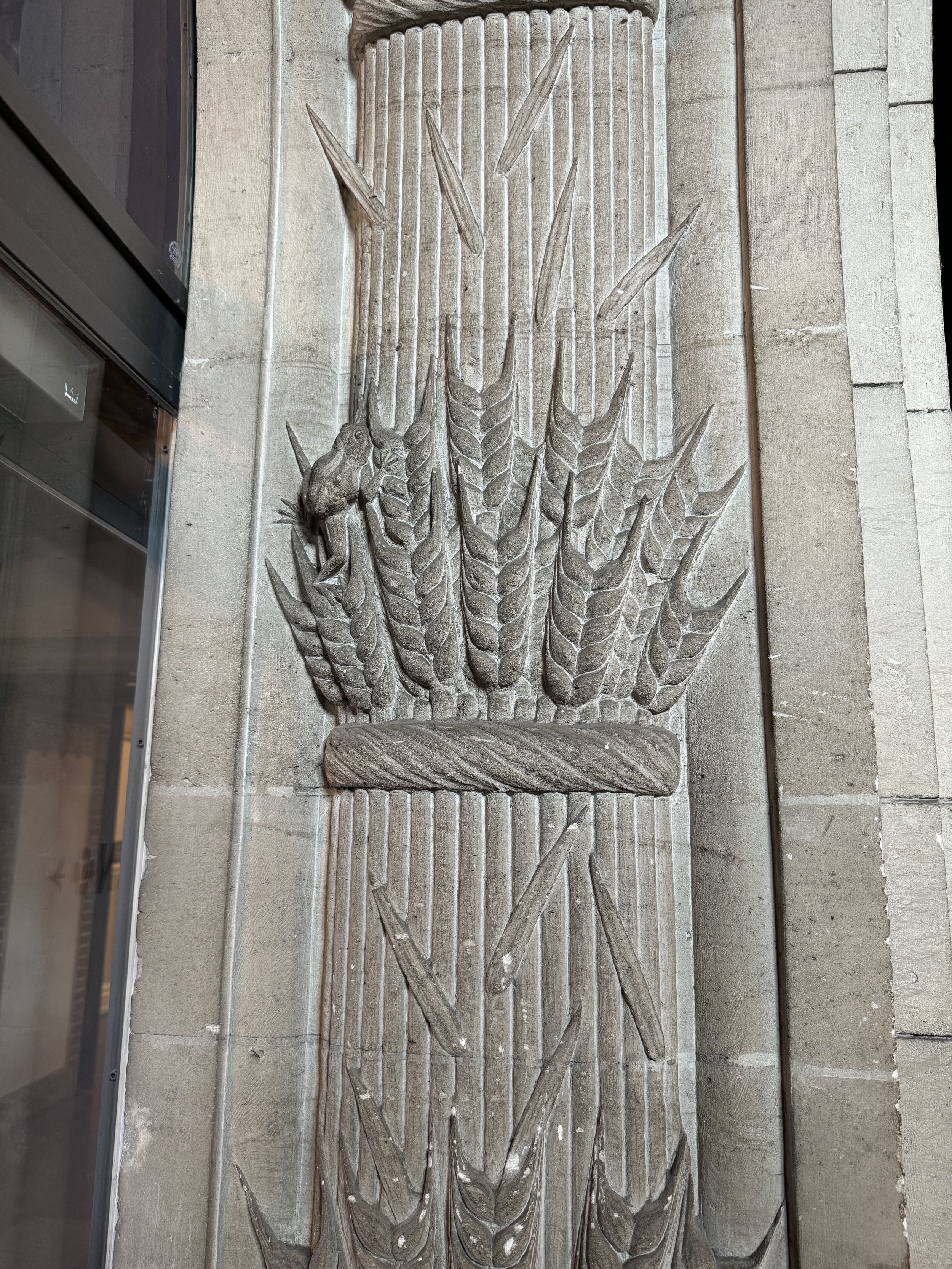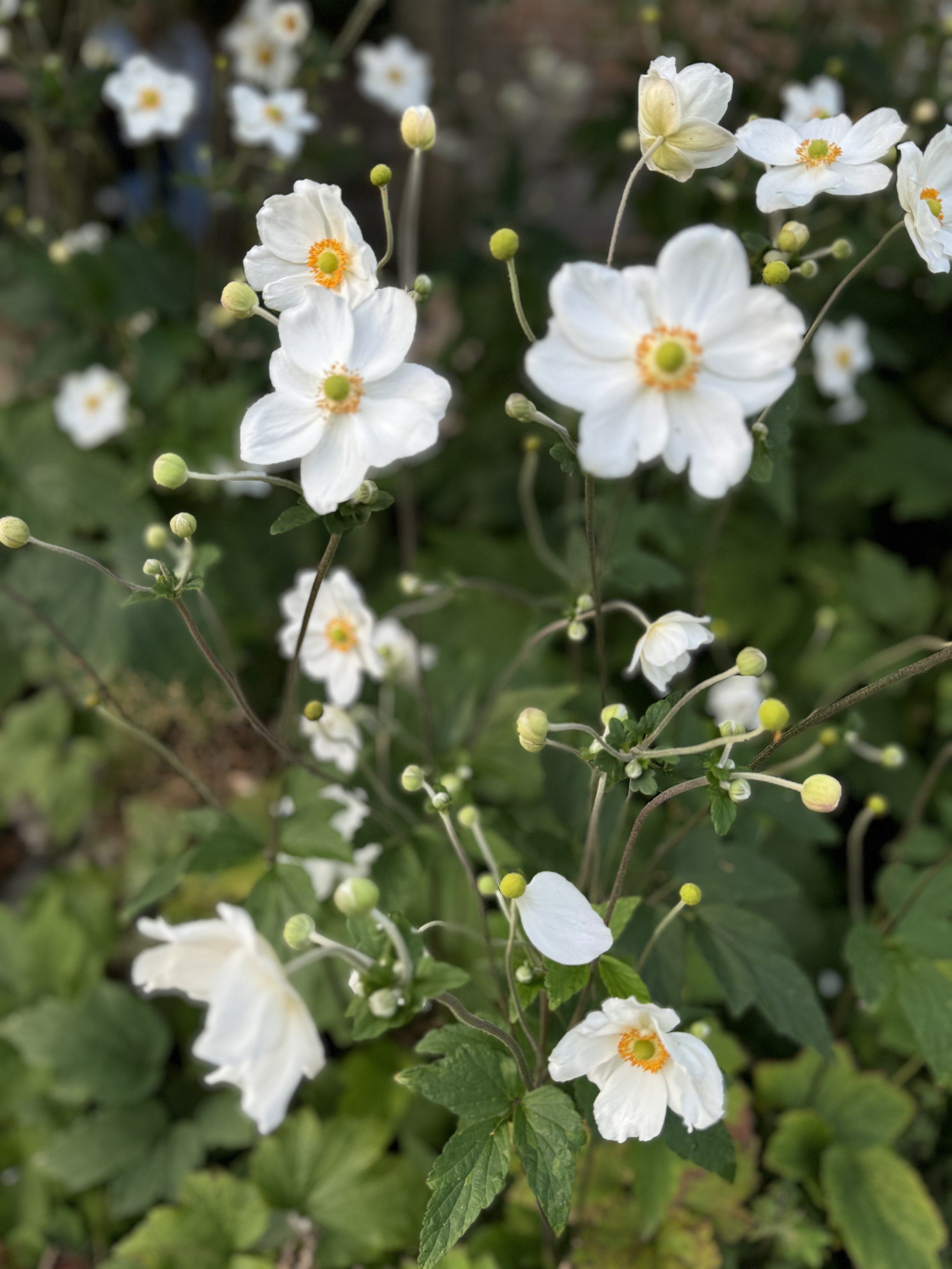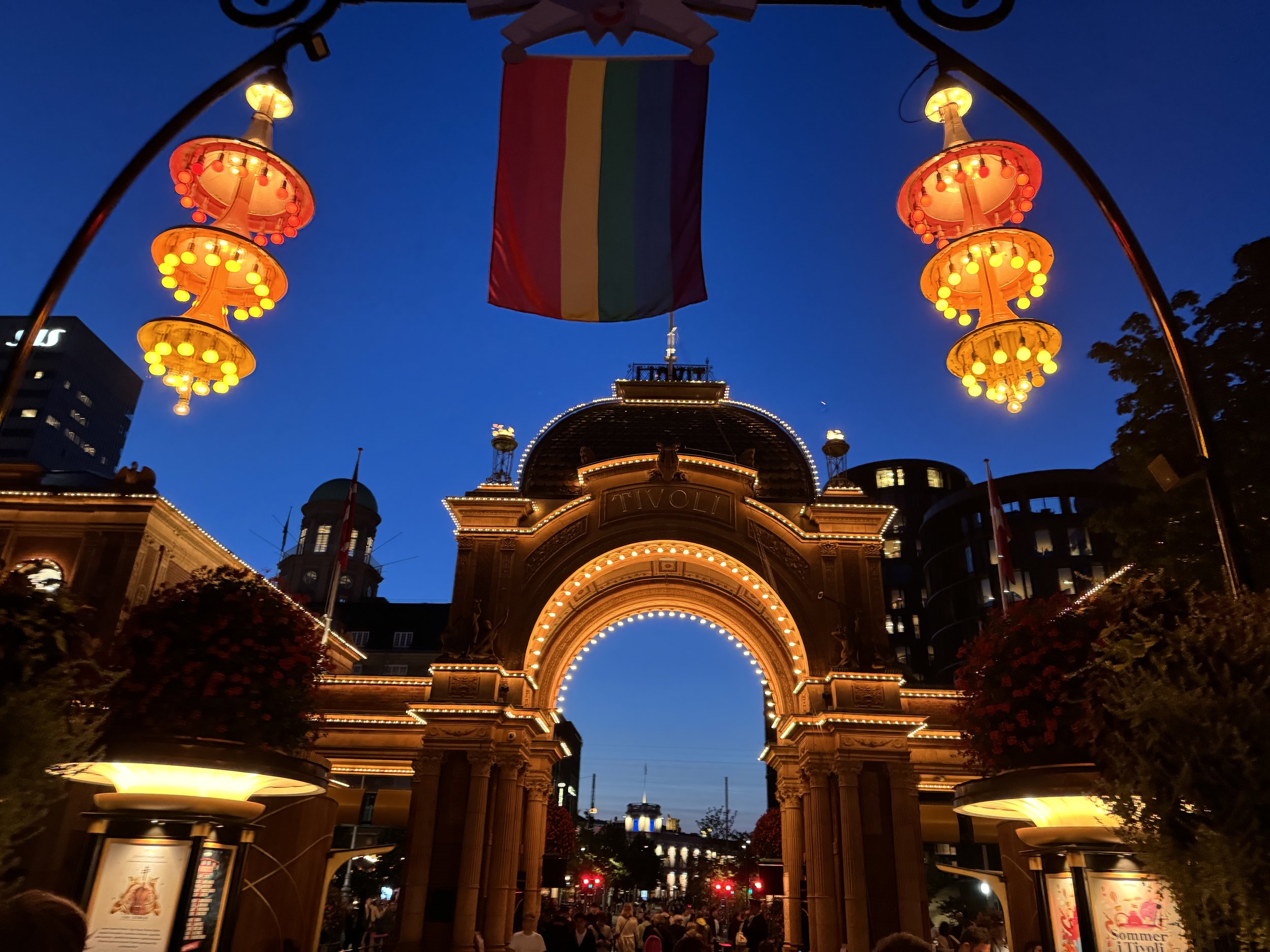A Night in Tivoli Gardens
After a day of rollercoasters, rides, parades, pastry and coffee!
Today was another amazing day in Copenhagen! We woke up early to make our breakfast reservation for 8:30 at the breakfast restaurant (yes they have a special restaurant for breakfast). The Square Hotel provides an amazing breakfast spread buffet some amazing options like build your own granola bowls (all kinds of toppings and yogurts) to the lunch meats and delicious breads (yes, for breakfast - hello again, German-style breakfast) to gorgeously soft scrambled eggs with sausages and bacon and much more. We fueled up for the day and made our way out into the wild that is the city today. Copenhagen pride is still going, and man is it going hard! Our hotel is situated directly on the City Hall Square (Radhuspladsen ‘Rah-d-hoos-plass’), which is the CENTER of all pride festivities. Today we wove our way around the wreckage of last night’s concert to check out Copenhagen’s amazing city hall. After that, we sauntered over to the nearby Tivoli Gardens amusement park, exited to view the pride parade, and re-entered Tivoli Gardens for more rides and beautiful lights!
Copenhagen’s City Hall
We walked into the hall and immediately knew that we were in over our heads. There is so much thoughtful detail in the architecture and the decoration of the building. The building was finished in 1905 and has contains many different styles of architecture on the inside. We quickly got ourselves on the guided tour. It was a good choice too, because the guide was AWESOME and very funny.
Let’s take you through a summary of the tour so you have a little detail for the pictures that I’ll be uploading. On the front exterior facade of the hall, stands Bishop Absalon, the credited founder of Copenhagen. He built a fortress on the islet of Slotsholmen (where the government is now quartered) to protect the port town from attack by the German Hanseatic League. Gradually the city took shape and expanded, due to its importance, being located on the Sound between the North Sea and the Baltic Sea as a major port.
There were other city halls before this one; however, the one we toured today is the largest city hall in Copenhagen’s history. Though it was finished in 1905, the hall bears witness to and hosts the vast history of the city. It does so by engraving all of the city’s major historical events across the walls in the great hall, and it hosts an archive of all of its own historical documents. Citizens may come and research those documents in the archive in order to learn more about the history of their city.
The first thing that we did on the tour was to walk outside. The guide pointed out all the couples and their families outside, who were waiting to be married! He not so sheepishly boasted that Copenhagen is responsible for over 6000 weddings every year, no matter who you are or who you love. Marriage seekers need only to complete the proper paperwork, go into the hall to the designated office on one side of the building, Then they come out the other side married and eager to celebrate with their close friends and family. We noted throughout the morning that there was, indeed, a steady line of people getting married right there and right then.
The tour progressed inside to the hall’s foyer. On 2 columns, posted on either side of the inner door, are carved two cobra snakes. They sit on the columns guarding the door to the grand hall, and they are meant to imply that they will strike at anyone who comes to this hall with evil intent. Above this well protected door is a stunning relief carving of the first head mayor of Copenhagen and citizens. It was explained that all of the official action and ruling of the citizenry was traditionally done outside and never inside. Although this has changed, there are some cool references to that outdoor tradition later on.
When you enter the great hall, you immediately notice a change in style and area. The small doors cast you into a wide open grand hall with a large windowed ceiling. This ceiling was actually installed much later, and the original hall was open-air. Denmark famously has rainy and cloudy weather, so the hall was eventually closed. The far wall of the hall is done in an Italian style with two levels of windows looking into the hall. The City council is housed on the second floor, and the offices of the various city departments and the city archive are on the first floor. The hall has a tremendous amount of imagery referencing water, elements, fauna, flora, and historical events. One of the particularly neat things was an archway, the “Wheat Gate,” leading to the “Golden Stairs.” This archway depicts a field of wheat in stone relief, and hiding amongst the wheat are animals as elemental representations. There is a lizard for fire, a bird for air, a rat for the land, and a frog for the water.
The referenced “Golden Stairs” lead upstairs to the city council’s anteroom and plenary room. On the stairs, on both sides of the building, are carved various depictions of citizens engaged in their professions. There are paintings of citizens on the stairwells, and there are busts of people faces everywhere. They are always watching you from the walls and the ceilings wherever you go in the building. This reminds officials and fellow citizens that the city hall is a place for ALL citizens, and that there are always people watching. The golden stairs have gold gilded railings along a beautiful marble stairwell.
On the other side of the hall are the “wooden stairs,” an elegant wooden stairwell with paintings of the sea-faring and land-faring aspects of Copenhagen, tying together its two important themes in history as port and bountiful agricultural center. When the Queen of Denmark would visit, she was required to use the wooden stairs to traverse the building. This is a cool tradition, and it is to illustrate humility and understanding that this is the peoples’ house, and it does not belong to the queen.
The tour guide led us through the plenary room, where he gave us a pretty good rendition of his own interpretation of representative democracy. He explained the basic concepts of elections, political parties, and representation. He even gave us quite the amazing demonstration of plenary process and debate, as he stood in the center of the plenary room and said, “this is where they stand up in front of everyone else and go blah blah blah blah!” Given my own work experience in a foreign legislature, I could not think of a more accurate description. Well done, sir. Well done. I shall heretofore refer to this moment fondly as my first Danish civics course!
OK a few more cool things before I wrap this up. The keys that this man used to get into each locked door were neat. The bitting on these old iron keys was either a castle or three long bits, representing the 3 towers of the Copenhagen seal. With the castle key, he took us on a tour of a special room that is used for the reception of Copenhagen’s honored guests! The room is modeled after a sea-faring ship, with railings on both sides, as if you were standing on the main deck. All around the ceiling are the coats of arms of the various cities of Denmark with a special wall for its territories, Greenland, Faroe Islands, and the former Danish West Indies (today the US Virgin Islands). On this wall are two gold gilded walrus skulls with tusks, and a peculiar door. This door leads out to the exterior balcony on the front of City Hall. Our tour guide does not have a key to that door and has never been on that balcony. Only very important people like the queen or sports champions (like a recent international Handball champion) are presented to the people on that balcony. It is only for those special occasions when someone very important to the city or the nation os presented to the other citizens of the city/country. He showed us a cool video that he took on his phone of that handball champion being presented to the city from the window next to the balcony. There were massive crowds in the square cheering. It was really cool!
The tour having ended, Jessi and I milled around the place taking more pictures. We probably could have stayed there all day, but it was time to go explore…
Tivoli Gardens
Tivoli Gardens is a garden amusement park in the middle of the biggest city and capital of Denmark. Think of Hershey Park or Kings Dominion, or one of the better Six Flags condensed into the space of two or three full city blocks. There are rollercoasters, carnival rides, food joints, beer, wine, stages for the arts, stages for live music shows, and incredible gardens to enjoy. This park was one of the biggest reasons for us coming to Copenhagen. We wanted to come here and ride rollercoasters, and ride we did.
Tivoli Gardens is the third oldest operating amusement park in the world. It’s named after the Tivoli gardens in Paris, which are named for Tivoli in Rome. Did you follow that? Bah! What does it matter! There was food and fun and plenty of it. Jessi and I rode the Daemon rollercoaster, a delightful above-track steel coaster with a large loop. We rode a super high swings ride, and some spinny carnival rides until we were dizzy. We grabbed some lunch in the nearby Tivoli food hall, which hosts a tremendous assortment of cafe and imbiss options in styles from all over the world. There was everything from sourdough pizza and West African spicy to sushi, traditional Danish Smørrebrød and English brewpubs. We left the park to eat some delightful Smørrebrød (open faced sandwiches) and wandered off to watch the pride parade nearby back at the city hall!
The parade was off-the-hooks packed with all kinds, and it was amazing. There isn’t really a whole lot to say about it except that the atmosphere was wonderfully accommodative and accepting of all peoples and it was PACKED. Lots of people have descended onto Copenhagen for this event, and the party continues into one final night! Once Jessi and I had taken some cool pictures and gotten the vibe of the crowd, we decided to head back to our original mission of the day: Tivoli Gardens. We re-entered the park through the food hall and spent the afternoon eating junk food, walking through the gardens, and riding more rides. It was so much fun. We had a coffee on the field in front of the concert stage and watched the sun go down slowly. Then we meandered around the park as all the decorative lights came on and took some really cool photos of all the features we had seen earlier in the day all lit up. In particular, where are paper lamps and a dragon as well as exotic buildings in the style of Arabian architecture.
Now is the part where I backtrack a bit to the title of our blog entry today. Anyone who knows Jessi, knows about her “thing” for cake of late. Often I’ll make a special trip to the store to pick up some ingredient that I forgot for our dinner, and she will ask, “did you get cake?” This is as though I’m supposed to think of this every time I go to the store. Well…anyway…no sooner had we gotten through the gates of Tivoli Gardens in the morning, Jessi sees a cake and pastry shop. Surprise! That’s where we are going! NOW! The name? You can’t make this up…”Cakenhagen.” Yup. It has been a topic of conversation all day. Whether we should buy expensive admission tickets just to go to Cakenhagen in the park. Luckily on our way back to the hotel, we noticed that Cakenhagen has a shop just outside the park, which is accessible to anyone. Guess where we will be going for a snack over the next few days while we are in Copenhagen….or..over the next few years as Jessi applies for citizenship and starts googling for apartments closest to Cakenhagen?
Tomorrow, the city will be alive with an Iron Man Triathlon, taking place all over. We are planning on making it a museum day. If folks are out running/swimming/biking (or watching those activities) they aren’t crowding the museums right? We’ll see!
Thanks for following along with us…ok now here are the PICTURES!!
